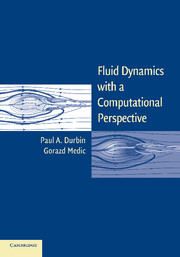4 - Intermediate Reynolds Numbers
Published online by Cambridge University Press: 28 January 2010
Summary
Separation, Vorticity, and Vortex Shedding
Most classical theory of viscous flow is based on approximations valid at low or high Reynolds number. Although there are a few exact solutions that illustrate aspects of the intermediate range, they are rather limited. The range of phenomena that fall under this heading is commonly illustrated by photographs taken in laboratories. Computational fluid dynamics makes the intermediate Reynolds number range quite accessible.
Inertia is now comparable to viscous stress, and all terms in the Navier–Stokes equations must be retained. Convection destroys the upstream–downstream symmetry of creeping flow (Chapter 3). A distinct wake can be identified leaving the downstream side of a body in an incident flow. Forces on blunt bodies become increasingly due to pressure rather than to viscous stress.
Vorticity is increasingly confined to regions near to walls on the upstream portions of a body and to wakes on the downstream side. The upstream vortical regions become boundary layers in the high Reynolds number limit. As vorticity diffuses away from the surface it is convected downstream, ultimately to form the wake. The upstream–downstream asymmetry leads to another important idea, that of separation. For example, flows into and out of a nozzle are quite different. The flow into a trumpet shaped orifice, say, will follow the walls. As the opening narrows, the flow accelerates to conserve mass [loosely, ρUA = constant, per Eq. (1.33), implies U increases as A decreases]. The accelerating flow convects vorticity toward the wall, keeping it confined near the surface.
Information
- Type
- Chapter
- Information
- Fluid Dynamics with a Computational Perspective , pp. 132 - 166Publisher: Cambridge University PressPrint publication year: 2007
